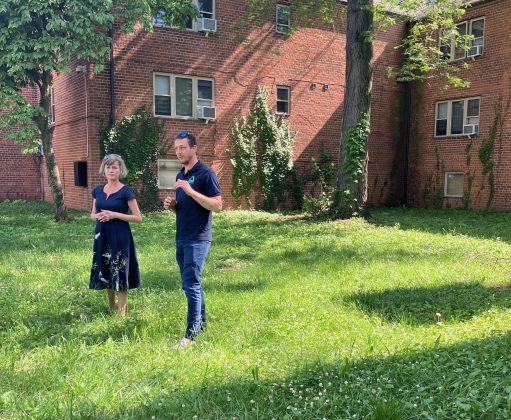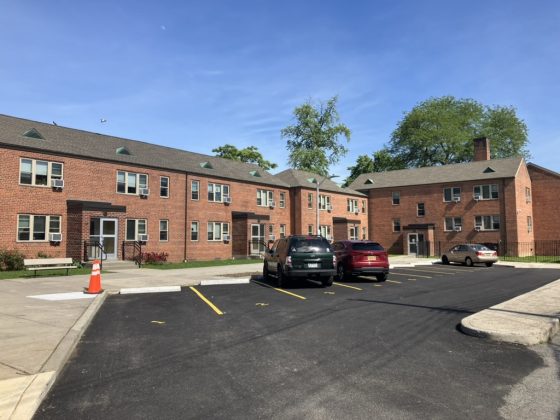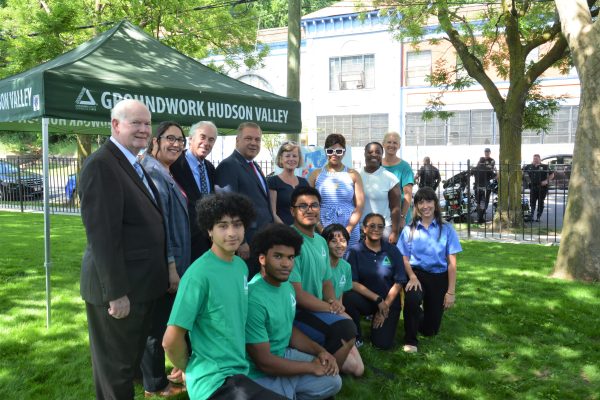Green infrastructure for a climate resilient yonkers

Due to its proximity to the Hudson River, geographic and socioeconomic factors, and dense urban landscape, much of Southwestern Yonkers, NY, is vulnerable to climate change-related flooding and heatwaves. This is especially true for those living in affordable and public housing across the city. Due to the long-term effects of redlining and other discriminatory practices over the last 75 years, much of the housing for seniors, low-income families, and residents with disabilities is located in areas disproportionately impacted by the climate crisis, including areas with limited tree cover, green spaces, and parks. Some properties are located near air-polluting manufacturing centers, municipal waste treatment plants, or along truck routes.
Through their Climate Safe Neighborhoods initiative, Groundwork Hudson Valley studied heat and flooding vulnerability across Yonkers. This mapping effort helped illuminate the climate risks disproportionately impacting Yonkers residents living in public and affordable housing. Many affordable housing options are energy-inefficient buildings that exacerbate negative health outcomes and increase the impact of extreme heat. To help mitigate this risk, Groundwork Hudson Valley is partnering with Municipal Housing Authority for the City of Yonkers (MHACY), the second-largest public housing organization in the NYC area, to renovate many of the properties, making them more accessible and climate-resilient.
Housing and heat
Among the first round of property renovations is the Loehr Court Apartments. This affordable housing property, managed by MHACY, is greatly impacted by the urban heat island effect. The apartments are located in a lot that is mainly concrete and pavement with few green spaces and even fewer trees. In the summer months, the brick apartments trap heat and are expensive to keep cool, but the lack of any shade structure or trees on the property means that, for many residents, inside is the safest option.

“You’re in your home, you can’t go out…if you go out and get too much sun, you’re on medication, then you’re going to pass out on the street somewhere. So, the only place to be safe is in your home, so you sit there all day, every day watching T.V.” Yolanda Lee, resident of the Loehr Court public housing apartments.
when it rains, it pours
Not only are the buildings vulnerable to heat, but they also lack adequate stormwater infrastructure to manage the increasing intensity of storms and rainfall. In the fall of 2021, Hurricane Ida hit the Yonkers community hard, flooding newly renovated MHACY properties with several feet of water. At the Loehr Court Apartments, which are located in a local “urban sink” – a low-lying, inland area that drains stormwater from the surrounding hills – the HVAC system, as well as new boilers and laundry appliances, all needed to be replaced due to water damage. In just this building alone, the repairs cost $1M.

1% Solutions for Climate Justice
We are looking at 100-year storms and flooding that are now happening every year, sometimes multiple times a year. We are looking at extreme heat, which kills more people than all other natural disasters combined. This is a real health issue, it’s a real livelihood issue, and it’s a real environmental issue. The fact that we have so many folks coming together to address this collectively gives me a great amount of hope.”–Brigitte Griswold, Executive Director, Groundwork Hudson Valley
With a $2M investment in hand, Groundwork Hudson Valley, in collaboration with MHACY and Westhab (an affordable housing nonprofit), is on a mission to address both extreme heat and flooding at Loehr Court and beyond. By retrofitting ten affordable housing properties with critical green infrastructure, including trees and vegetation, bioswales (channeled depressions in the ground that help control stormwater), and rain gardens, they will simultaneously tackle the interconnected affordable housing and climate crises. Their multi-pronged approach co-locates infrastructure solutions to create an impact that is greater than just the sum of the parts.
Trees, vegetation, and shade structures will provide cooler places for residents to spend time outdoors, while also helping to absorb and retain excess rainwater to limit flooding. Newly installed rain gardens will help reduce water pollution by filtering stormwater during large rainfall events. For more extreme storms, MHACY is working with other partners, such as FEMA, to install gray infrastructure solutions, including holding tanks and new pump systems, to divert large quantities of stormwater away from affordable housing buildings. To increase the impact of existing space, Groundwork Hudson Valley is also building community garden beds at Loehr Court for residents to grow fresh food, and constructing green spaces with seating around the property to provide shade and reduce the impacts of the heat island effect.
This combination of green and gray infrastructure strategies aims to provide holistic climate solutions that simultaneously address the vulnerabilities impacting the affordable housing community. Flood mitigation measures and an increase in the availability of shade and green space will help manage stormwater and reduce extreme heat, while also addressing climate justice and improving quality of life. Access to fresh produce from the community garden, and cleaner water and air from rain gardens and vegetation will improve health outcomes for residents.
Across all ten selected project sites, the team will convert 10 acres of impervious surfaces to natural biofilters, divert 250,000+ square feet of stormwater runoff, plant 100 trees, and restore 1,000+ feet of riverbank. These green infrastructure investments will decrease surface temperatures and improve flood management, addressing environmental inequities in the Yonkers community. Samantha Chiafalo, Assistant Vice President of Westhab, explains, “This investment is critical to reducing exposure to extreme heat and creating a sustainable future for the communities we serve.”
Changing Places, Changing Lives

Not only will the project have a direct impact on climate resilience, but it will also provide an opportunity for residents to learn more about the impacts of the climate crisis and what can be done to safeguard communities. Groundwork Hudson Valley is training Yonkers residents and employing youth as part of the Green Team to work directly on the construction of green infrastructure projects. Green Team members – Yonkers-based high school students – have learned from their own lived experiences about the urban heat island effect and the disproportionate impacts of climate change on communities with fewer resources to address these challenges. Using their personal experiences and green infrastructure training, the Green Teamers have been fierce advocates for the use of rain gardens to mitigate climate risks in urban areas and decrease pollution. Engaging local youth in these projects and giving them a leading role helps foster a sense of agency and prepares them to be the drivers of future change.
Not only are we doing good, but we’re making sure that the next generation understands why this is important.” – Andrea Stewart Cousins, New York State Senate Majority Leader, on Groundwork Hudson Valley’s affordable housing retrofits.
Groundwork Hudson Valley is also expanding its climate education and literacy programs to Southwest Yonkers through public outreach and media, to educate residents on climate resilience landscapes, heat mitigation measures, and extreme weather preparation. These programs will allow the community to inform climate interventions that will improve the lives of residents who are particularly vulnerable to climate risks.
To learn more about Groundwork Hudson Valley and its green infrastructure efforts, visit: Groundwork Hudson Valley
